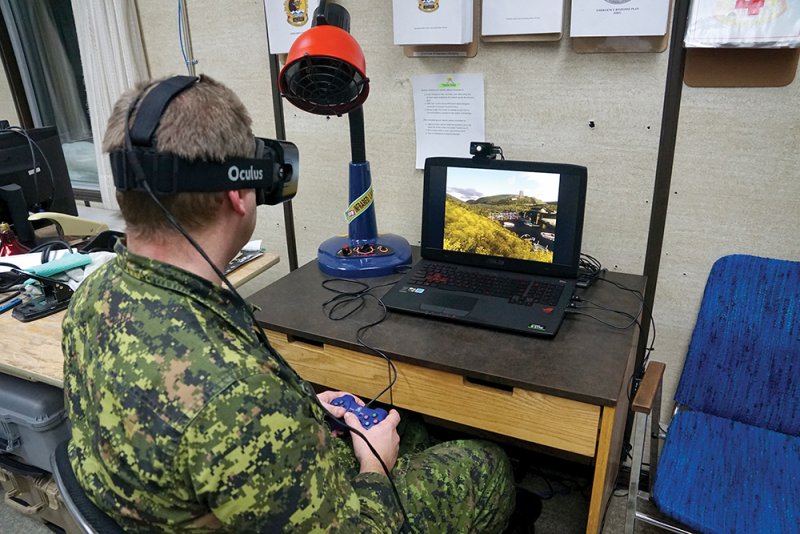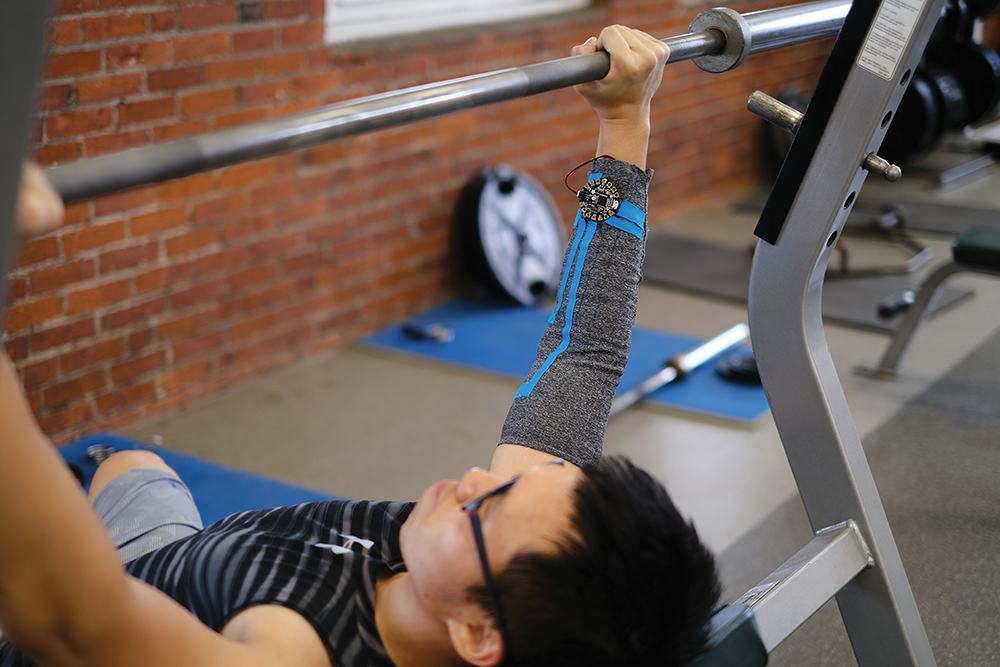In the past year, NH’s top research centers—the University of NH in Durham and Dartmouth College in Hanover—have achieved breakthroughs in a myriad of issues that range from preventing sexual harassment and tragic bridge collapses to developing virtual reality tools to help astronauts cope with the emotional stress of space exploration.
Here is a roundup of some of the intriguing research recently emerging form these NH institutions:
Living Bridge
In Portsmouth, UNH researchers have created a “living bridge” with the installation of several sensors on the Memorial Bridge that yield real-time information about the condition of the bridge and the environment.

The “living bridge” in Portsmouth. Courtesy of UNH.
“We call it a living bridge because it can talk to us and provide valuable information about its health—the stress it deals with, the ease at which it moves, what’s happening around it and even under it in the Piscataqua River,” says Erin Bell, professor of civil engineering and principal investigator of the Living Bridge project. “This bridge is not just for getting us across the water, it can teach us so much more about the world around us.”
Bell says the bridge was fitted with 40 self-diagnosing sensors that provide researchers, engineers and the general public with information about structural performance, such as weight on the bridge, the behavior of the towers during a bridge lift, strain and acceleration, as well as traffic patterns, weather conditions, sea level and tidal information. It will also provide bridge design engineers unique and innovative information to help create the next generation of bridges with maximum safety, reliability and efficiency.
The information gathered will help identify any potential risk factors that if left unchecked, can lead to tragedies like the 2007 bridge collapse that happened in Minneapolis St. Paul, Minn.
“Data for the sake of data doesn’t help anybody,” Bell says. The data and methodology can be used to improve safety and help preserve the Memorial Bridge and other infrastructure projects before an emergency would develop, she adds.
Speed Bumps in Space
UNH and Dartmouth College researchers continue to work with NASA to understand how aurora speed bumps affect satellites orbiting the Earth and to develop new coping tools to aid future space explorers.
UNH researchers recently published a study showing that the Northern Lights, or auroras, help to move pockets of air high in the atmosphere, which then cause drag on passing satellites, essentially creating speed bumps in space.
Developing ways to compensate for the drag caused by the speed bumps can prevent the loss of satellites.
Stress in Space
In Hanover, astronaut and physician Jay Buckey Jr., a professor of medicine at the Geisel School of Medicine at Dartmouth College, is leading research into using virtual reality (VR) to help people, such as explorers on Mars or in the Antarctic, better cope with the psychological stresses of working in remote, isolated and extreme locations. The hope is the project can help aid future space missions to Mars.

Canadian military personnel try out virtual reality at the Canadian Alert Station, the northernmost permanently inhabited place on Earth. The VR tool was designed by professor Jay Buckey Jr. at Dartmouth College’s Geisel School of Medicine. Photo by Allison Anderson, Ph.D.
The VR tools designed by Buckey are aimed at improving people’s abilities to manage stress, resolve conflict or treat depression.
Improving Sexual Harassment Prevention Programs
In the era of the #MeToo movement, researchers at UNH have delved into the results of sexual assault and harassment prevention programs offered on college campuses to look for ways that companies might be able to improve their in-house prevention programs and policies.
“There are some valuable lessons to learn. First, the more effective training used on college campuses is more immersive and takes place over several weeks or even months. Second, there is more commitment to measurement. Unless you follow up programs with detailed surveys or other instruments, you don’t know whether a change in attitude has stuck,” says Jennifer Griffith, a UNH assistant professor of organizational behavior and management.
In the study, Griffith and co-author Kelsey Medeiros, an assistant professor of management at the University of Nebraska-Omaha and a fellow at UNH’s Prevention Innovations Research Center, evaluated more than 30 years’ worth of peer-reviewed research on sexual assault and harassment prevention programs. They found in a college setting the programs that were more interactive were more effective.
Their study focused on helping businesses and groups to measure the effectiveness of their plans to make sure they are working.
Exploring Autism
UNH researchers continue to dive deep into the human brain to understand the complexities of autism. Researchers have known for a while that autism is four times more prevalent in boys than in girls, but now they may be closer to understanding why.
A recent UNH study is the first to look at the sex-biased regulation of proteins in the brain and examine the role they may play in affecting abnormal changes in the body that result in autism, according to Xuanmao (Mao) Chen, assistant professor of neurobiology. “Our findings point to a new direction for autism research and suggest promising possibilities for creating novel treatment strategies,” he stated in a press release.
In the study, published in the journal Frontiers in Cellular Neuroscience, the researchers looked at an enzyme called AC3 that is genetically connected to major depressive disorder, obesity and autism spectrum disorders.
Improving Breast Cancer Treatment
When women are screened for breast cancer and doctors detect a lesion, known as atypical ductal hyperplasia (ADH), often it is surgically removed so it can be tested for cancerous cells. Women soon may be able to forego such procedures.
A Dartmouth research team led by Dr. Saeed Hassanpour at the Geisel School of Medicine found a method using computer algorithms and statistical models to predict whether such lesions may be cancerous. Having this information can potentially help clinicians and low-risk patients decide whether to use hormonal therapy rather than surgery to remove the lesion.
Evaluation of the model demonstrated the computer modeling can identify 98 percent of all malignant cases prior to surgery while sparing 16 percent of women from an unnecessary operation for a benign lesion. The Dartmouth team’s results were recently published in JCO Clinical Cancer Informatics.
Smart Fabric
Imagine if someone hurt their shoulder or elbow and could get better by wearing a special sleeve. Associate Professor of Computer Science Xia Zhou and her team at Dartmouth developed a wearable, low-cost motion-capture textile that monitors joint rotation to help athletes and patients recovering from injuries.

A demonstration of the wearable, motion-capture textile developed at Dartmouth College. Photo courtesy of DartNets Lab and Dartmouth College.
The prototype has been created for the elbow joint, but Zhou says it can be adapted to treat the knee, shoulder and other joints. The smart fabric was recently featured in the National Science Foundation’s “4 Awesome Discoveries You Probably Didn’t Hear About This Week” social media campaign.
Disappearing Bees
UNH researchers have been studying the decline of 14 wild bee species in the Northeast to better understand the effects of climate change.
Bees pollinate several important cash crops for local farmers, including apples, blueberries and cranberries. The study, recently published in the journal Insect and Conservation Diversity, used local museum records to compare changes in wild bees in NH between 1891 and 2016. Researchers examined data about habitat preferences, range, elevation, latitude and social behavior.
Researchers found wild bees in the southern part of the state, particularly along the coast, have been declining while those in the White Mountains region have persisted. The data about habitat shifts in wild bees can be used to develop strategies to improve landscape management, crop production and conservation policies.
Thicker is Better
UNH researchers recently released data showing increasing the thickness of asphalt on certain roads will extend the life cycles of those roads that may otherwise be eroded by the effects of climate change.
The study, published in the journal Transportation Research Record, states while changes to lengths of seasons will affect the durability of roads, a 7 to 32% increase in the asphalt-layer thickness might be the best way to extend their use.
